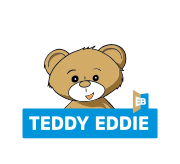Christmas is coming 😊 Therefore I want to share with you some ideas for games that can be played during Christmas lessons with kindergartners and children in the first or second class of primary school.
Game No. 1 COLOURFUL ROPE
What would you need? Of course, a colourful rope 🙂 … as well as picture cards.
How to conduct?
- We draw a line on the board and we put picture cards on both sides (for those groups that can read the pictures should be signed; the bare writing can also be sufficient enough).
- We lay the colourful rope down on the floor.
- We say an easy sentence (e.g. It’s a star) or more difficult one (e.g. I can see a big star in the sky) containing a chosen word from the board.
- The children’s task is to stand on the proper side of the rope.
- While the children are completing the task we point at the proper picture and repeat with them the sentence that has already been said so the kids could remember the vocabulary better.
- After a while, it is a good idea to leave it to one of the kids, the kid will be saying the sentence and the rest of the group will be choosing the right side of the rope.
Game No. 2 – LET’S DANCE!
Nothing puts you in a Christmas mood like a Christmas song or a carol.
What would you need?
The song „We Wish You a Merry Christmas” – our “bear”’ teachers can find it on the teacher’s record attached to the RED book. Various versions of this song can be also found on the Internet.
How to conduct?
- We choose some phrases from a song, for example Merry Christmas, Happy New Year, a stocking, Santa and so on.
- We teach children the meaning of the chosen phrases, for instance, by making English-Polish echo. For groups with children that can read we put those phrases down on the board.
- We tell the kids at which phrase they should stand still. It is advisable to make sure that the children understand the discussed phrase (otherwise, the educational goal of this game is questionable). For groups with children that can read we point at the phrase on the board and then, read it together.
- We play the song and dance with the children in a circle, holding hands.
- The children’s task is to stop when they hear a chosen phrase/phrases.
Modifications for “more advanced”
- Children dance in pairs, each pair gets a different phrase, one pair for example “Merry Christmas”, second one “Happy New Year”, a pair has to stop when it hears its own phrase.
- Children can also choose a phrase by themselves or one pair can pick a phrase for another one.
- If we want to make it even harder for our sweethearts we can ask one, two or even more kids to dance in time of a carol and stand still when they hear a phrase chosen by them. The rest, observing dancing kids, should guess what was the phrase.
Game No. 3 SENSITIVE EAR
What would you need? Picture cards – the same as in the Game No. 1, but with two or three copies of each picture.
How to conduct?
- We put the pictures up on the wall, alternatively we put them on the floor (but then, they are simply less visible).
- We play a Christmas song in the background. Suddenly, we stop the track and we say a sentence containing a chosen word (depending on the group’s proficiency we choose an easier or more difficult word).
- The children’s task is to stand next to the right picture; however, there could be only two or three kids next to the particular picture, the rest should look for the other copy of the same picture.
Modification in a group with children learning to read: we can introduce a vocabulary in two sets: pictorial and written; therefore, there will be pictures as well as words hanging on the wall.
Game No. 4 WHAT PICTURE DO WE HAVE?
Last but not least, a dynamic game for older kids (at least 5 to 6 years old, it does not work with younger children).
What would you need? Picture cards, like in the previous game, and plastic badges (“bear”’ teachers can find them in the Eddie’s Box).
How to conduct?
- We choose as many pictures as we have children present and we prepare two copies of each type. We divide pictures into two identical groups.
- We take one half of the pictures and ask each child to put one picture on the board using a blue tack or a magnet. Thanks to that kids are having fun and we are gaining some time to place the pictures on the badges. We manage to do that.
- We repeat the words pointing at the pictures on the board – quickly and dynamically – without that revise, the game may turn out to be a disaster.
- We arrange children in trios and ask them to position themselves face to face. Then, we place one badge with a picture on each child’s back. Before placing the particular picture we show it to the child, it has to know which picture it has and what is a word – however, the other two kids from a trio should not see the badge.
- On our mark (for example, a clap or a “Merry Christmas” shout), children in trios should peek at the pictures fixed on the backs of the other two kids and say the word out loud, but they cannot let the others to look at their pictures. The pictures on the board are a kind of a “cheat sheet” which helps the children guess what is on their friends’ back.
- A child whose picture has been guessed should sit back with picture on its back directed to the wall. If there are three children sitting who were not in one team previously, the game for them may start from scratch.
- When all of the pictures, or most of them, have been guessed, we can play for the second time by exchanging pictures between the children.
If you have your own successful ideas for Christmas games with young children, you can share in comments. I wish you all great fun with Christmas class and recharge your batteries during Christmas break!
————————————
BOGDNA ŚMIEJA is a pedagogue with many years of experience in working with children. She has been one of the Teddy Eddie method trainer since April 2015. She runs workshops for teachers as well as online inspections of the lessons in our accredited centres.

